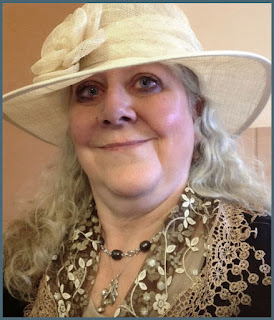Where the Past haunts the future... Damage to her mast means Sea Witch has to be repaired, but the nearest shipyard is at Gibraltar. Unfortunately for Captain Jesamiah Acorne, several men he does not want to meet are also there, among them, Captain Edward Vernon of the Royal Navy, who would rather see Jesamiah hang.
The love of my fictional life is Captain Jesamiah Acorne. I first met him on a rain-drizzled beach in Dorset, England, back in the autumn of 2005.
I’d had an idea for a pirate-based novel – having enjoyed the first Pirates of the Caribbean movie but wanting to read something along the same lines: a swashbuckling adventure romp with a dash of romance and fantasy. I found plenty of ‘straight’ nautical fiction, mostly written by men for men, and quite a few good Young Adult stories, which were interesting but, for obvious reasons, did not have ‘adult’ content. So I decided to write my own.
There I was on this deserted beach. I had my lead female, my pirate ship, a basic plot. But no pirate captain. I sat on a (wet) rock and gazed at the grey English Channel. Looked up, and saw him, a few yards away. Dressed in full pirate regalia, gold acorn earring dangling from his ear, blue ribbons fluttering from his curly black hair.
“Hello Jesamiah Acorne,” I said.
He looked back at me, smiled, touched his three-corner hat with one finger – and vanished.
And I swear that story is true.
Since then I have written five full-length Sea Witch Voyages, a short read -prequel story and recently published the sixth Voyage,
Gallows Wake.
There will be more!
Read An Excerpt from Gallows Wake: Jesamiah had been aboard a Royal Nav frigate, but the crew have been captured by the Spanish...
Cádiz, Spain 1719Someone was patting Jesamiah’s face. None too gently.
When I wake up, he thought, I’ll bloody pat their face.
“Wake up, man. Come on, enough of this, it is time to rouse yourself.”
Reluctantly, Jesamiah stirred, opened his eyes and looked directly into the stern, but concerned, face of Captain Edward Vernon.
At least, Jesamiah thought it was Vernon. The man had a bedraggled appearance, disorderly, dirty, hair and a generous amount of unshaved stubble. Captain Vernon, the real Captain Vernon, was a stickler for tidiness and cleanliness. The voice was Vernon’s though.
“Fetch him some of that water,” Vernon ordered to someone squatting close by. The someone rose, came back with a dented tin mug half-filled with green, scummy water. Vernon took it, held it to Jesamiah’s lips.
“’S’truth, but that tastes as foul as a latrine pit!” Jesamiah grumbled, pushing the mug away.
“You have a familiarity with drinking from latrine pits, then, do you?” Vernon asked, not bothering to conceal his disdain for the man before him. The earlier concern, it seemed, was not directed at Jesamiah’s wellbeing but for the fact that he was not awake.
“Aboard your ship I did,” Jesamiah retorted. He shifted position, stiff from lying prone on a hard, damp floor. Winced, then yelped as pain in his arm, face, thigh and almost all his body hurtled through him.
“We need you to wake up,” Vernon insisted. “They tell me that you speak Spanish?”
Jesamiah blinked at him, not quite understanding. They? Who were ‘they’? He peered over Vernon’s shoulder, realised their surroundings. A prison cell, packed with crew from the Bonne Chance. Thirty or so men?
“What happened?” he croaked, again, wincing, trying to sit up. Hands reached out to help him. Richard Tearle. The ‘they’ in question?
“Spaniards took us,” Tearle explained as he propped Jesamiah against the wall. “We know twenty-eight are dead; another six here will not see many more sunrises. You’re one of the wounded. One of the lucky ones to be alive.”
Lucky? The pain was increasing. Jesamiah did not believe in luck. It let you down too often. He growled something crude about the consequences of luck.
“How long have we been here?” he asked, wrinkling his nose at the overwhelming stench.
“You’ve been drifting in and out of consciousness for nine days,” Vernon informed him. “Which is why you really do need to pull yourself together and wake up.”
The question ‘why?’ filtered through Jesamiah’s mind, but he quickly answered it: Because this is a Spanish gaol and I can speak Spanish. Except, he had no wish to wake up or to speak Spanish. Nor did he want any Spaniard to discover who he was. His present name was Oakwood and Oakwood he would stay. End of discussion.
His head thumped as if an entire militia were beating to quarters in there. He felt with his right hand. A tender lump the size of a duck’s egg – no, bigger, a goose egg. His face throbbed too. He brought his hand lower, felt a stitched gash snaking across his cheek.
Tearle explained. “Surgeon says you have concussion. Been in and out of awareness all this time. You’ll have a scar but he reckons it will fade in time. He says you were lucky there too, could have lost an eye.”
“Nine days?” Jesamiah queried. “We’ve been here nine days?”
“Six. They kept us locked up aboard their Spanish ship at first. The Santa María del something or other.”
“Santa María del Bartolomé,” Jesamiah corrected. Perhaps they were lucky? Most Spaniards, as with pirates, would simply have tossed prisoners overboard. “And where exactly is ‘here’?” Not entirely certain that he wanted to hear an answer to his question.
“Cádiz. The Castle Tarif, or some such name,” Vernon answered.
Jesamiah again put him right. “Do you mean Castillo de Tarifa? Shite.”
“Aye, that is probably the only thing we will ever agree on, Acorne,” Captain Vernon said, grimly. “Shite.”
“Oakwood,” Jesamiah reminded him. “If you wouldn’t mind. Oakwood. My real name ain’t harboured by many friends in these parts.”
“I have no care as to what you call yourself,” Vernon retorted with a snort. “All I am interested in is getting these Spaniards to understand that I and my officers have a right to parole and exchange. So far, the imbeciles are refusing to understand the King’s English.”
“German,” Jesamiah muttered as the overwhelming impulse to go back to sleep flooded through his thrumming head. “King George of Hanover is German, can’t talk a word of English.”
“Nonsense,” Vernon snapped, “he only makes pretence of not doing so, though I grant his accent is lamentably hard to decipher.”
“Met ’im personally ’ave you? Heard ’im mangle the language?” Jesamiah countered.
Tearle interrupted. For the first time, Jesamiah noticed that he had a ragged bloodstained bandage bound around his right bicep and a black eye beginning to turn a lurid shade of purplish yellow. He guessed his own face was a similar colour.
“We need you to negotiate for us, Jes. And Captain Vernon needs to know what they have done with the rest of his men.”
“If they discover who I am,” Jesamiah repeated his earlier statement, “I’ll not be negotiating anything for anyone, I’ll be swinging from a gibbet.”
Helen Hollick
# # #
About the Author
Helen Hollick became a USA Today Bestseller with her historical novel, The Forever Queen (titled A Hollow Crown in the UK) with the sequel, Harold the King (US: I Am The Chosen King) being novels that explore the events that led to the Battle of Hastings in 1066. Her Pendragon’s Banner Trilogy is a fifth-century version of the Arthurian legend, and she writes a nautical adventure/fantasy series, The Sea Witch Voyages. She is now branching out into the quick read novella, 'Cosy Mystery' genre with her new venture, the Jan Christo-pher Murder Mysteries, set in the 1970s, with the first in the series, A Mirror Murder incorporating her, often hilarious, memories of working as a library assistant. Her non-fiction books are Pirates: Truth and Tales and Life of A Smuggler. She lives in an eighteenth-century farmhouse in North Devon, runs Discovering Diamonds, a review blog for historical fiction, and occasionally gets time to write. Find out more at Helen's website
https://www.helenhollick.net and find her on
Facebook and Twitter
@HelenHollick























.jpg)








